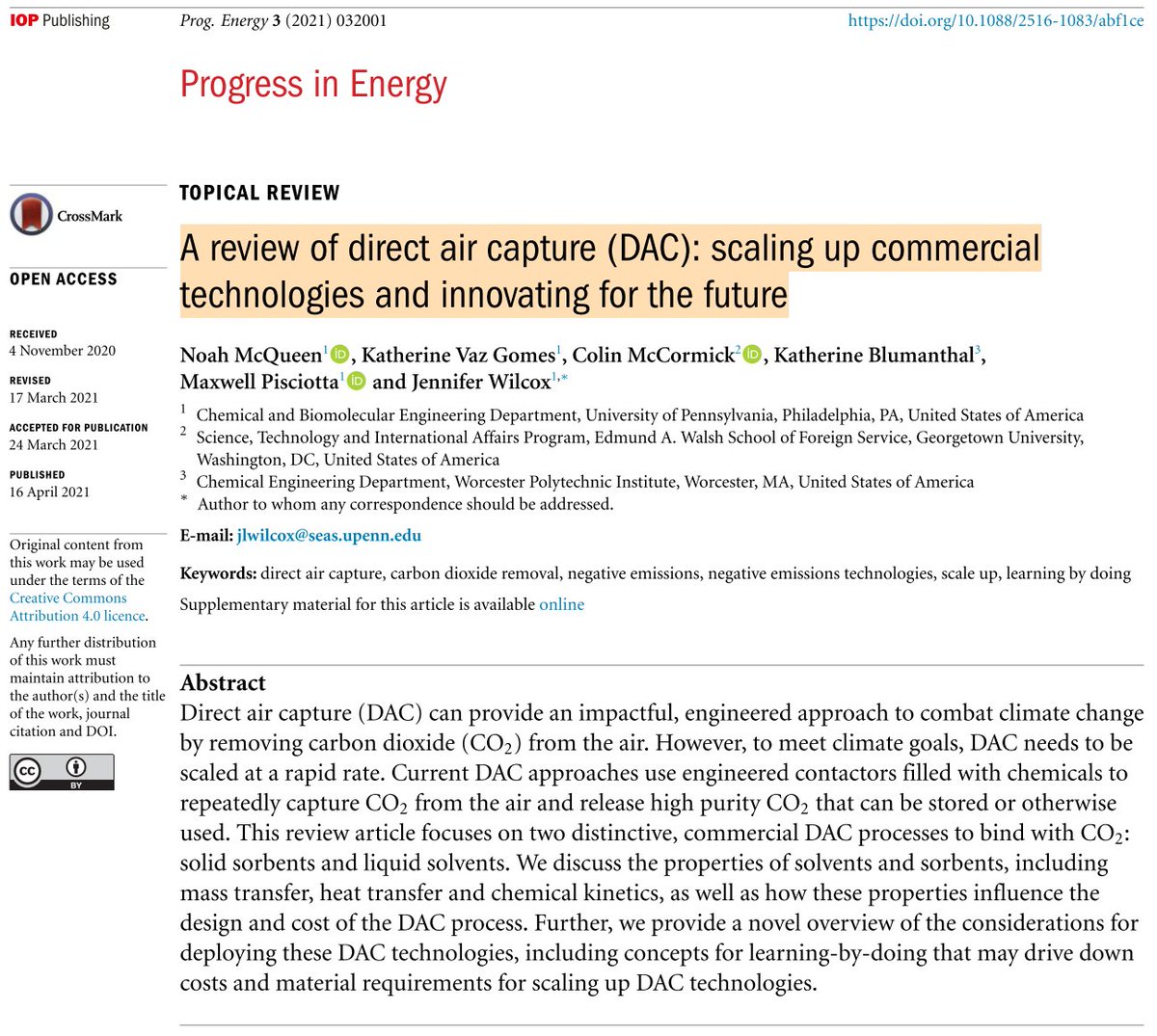
1. 📚 LITERATURE 👏 REVIEW 👏
2021 - A review of direct air capture (DAC): scaling up commercial technologies and innovating for the future
Threads to highlight important & interesting nuggets of academic info.
Don't trust me, I'm human:
doi.org/10.1088/2516-1…
2021 - A review of direct air capture (DAC): scaling up commercial technologies and innovating for the future
Threads to highlight important & interesting nuggets of academic info.
Don't trust me, I'm human:
doi.org/10.1088/2516-1…

2. #DAC is a developing approach to negative emissions technology (NET), necessary to ensure that global temperatures remain low.
"[NETs] must be used to offset sectors that are hard to de-carbonize and to repay the debt held by the planet's carbon reservoirs."
"[NETs] must be used to offset sectors that are hard to de-carbonize and to repay the debt held by the planet's carbon reservoirs."
3. The principle of a DAC device is to filter #CO2 out of thin air, producing a more concentrated stream of CO2 at an #energy cost.
"To meet our #climate goals, 10B tons/yr [of CO2] must be removed globally by 2050... DAC currently removes 1000s of tonnes of CO2/yr"
"To meet our #climate goals, 10B tons/yr [of CO2] must be removed globally by 2050... DAC currently removes 1000s of tonnes of CO2/yr"

4. DAC has inspired many approaches, hwr, this review focuses on liquid-solvent and solid-sorbent DAC technologies.
Typically different technologies are distinguished by their phase (solid v. liquid) and their regeneration process, i.e., how the 'atmospheric filter' is cleaned.
Typically different technologies are distinguished by their phase (solid v. liquid) and their regeneration process, i.e., how the 'atmospheric filter' is cleaned.
5. After your filter (I like to think of it as a sponge) is saturated with CO2, you have temperature, pressure and electricity at your disposal to rinse your sponge.
Thus, introducing temperature-, pressure- and electro-swing processes.
However, there's variation and nuance!
Thus, introducing temperature-, pressure- and electro-swing processes.
However, there's variation and nuance!
6. Some examples:
Adsorption/capture: 📬
Desorption/rinsing: 📭
📬 Ambient-T → 📭 High-T
📬 Cryogenic-T → 📭 Ambient-T
📬 High-P →📭 Ambient-P
📬 Ambient-P → 📭 Vacuum-P
📬 Arid → 📭 Humid
📬 Charged → 📭 Uncharged
And hybrid systems are very much welcomed :-)
Adsorption/capture: 📬
Desorption/rinsing: 📭
📬 Ambient-T → 📭 High-T
📬 Cryogenic-T → 📭 Ambient-T
📬 High-P →📭 Ambient-P
📬 Ambient-P → 📭 Vacuum-P
📬 Arid → 📭 Humid
📬 Charged → 📭 Uncharged
And hybrid systems are very much welcomed :-)
7. Ultimately the goal is to bring capital and operating costs down, to enable a rapid global-scale implementation DAC, while remaining environmentally conscious with regards to raw materials and end-of-life disposal/#recycling.
8. Keeping cost down is a non-trivial optimisation of:
→ CO2 sorption capacity (per mass of sorbent),
→ the sorbent lifetime (it's stability),
→ the time per regeneration cycle,
→ the energy cost per regeneration cycle and
→ the cost of manufacturing the device itself.
→ CO2 sorption capacity (per mass of sorbent),
→ the sorbent lifetime (it's stability),
→ the time per regeneration cycle,
→ the energy cost per regeneration cycle and
→ the cost of manufacturing the device itself.
9. Current price estimates depend on the boundary conditions considered for the analysis, the sorbent technology and the source of energy.
Tables 2. and 3. outline literature cost estimates for solid-sorbent ($86-233/tCO2) and liquid-solvent ($147-610/tCO2) DAC respectively.

Tables 2. and 3. outline literature cost estimates for solid-sorbent ($86-233/tCO2) and liquid-solvent ($147-610/tCO2) DAC respectively.


10. The review also considers how "learning-by-doing may impact costs and what constraints the global supply chains may place on continued [gigatonne-scale] deployment"
The learning rate (LR) is uncertain (0-30%), making cost projections very difficult - read article for details

The learning rate (LR) is uncertain (0-30%), making cost projections very difficult - read article for details


11. W.r.t. material requirements, both solvent and sorbent approaches could require significant concrete/steel infrastructure as well as the large sorbent/solvent contactors themselves.
Solvent system require additional centralised infrastructure for solvent regeneration.
Solvent system require additional centralised infrastructure for solvent regeneration.

12. While central regeneration benefits from economies of scale, solid-sorbent systems remain modular, which tend to have higher LRs among emerging technologies.
Modularity also facilitates mass-production and rapid implementation of improvements in design and manufacturing!
Modularity also facilitates mass-production and rapid implementation of improvements in design and manufacturing!

13. The industry is young, with Carbon Engineering, Climeworks and Global Thermostat as the leading companies. As of 2019 only 15 DAC farms were operating worldwide but with more in advanced development, with the goal of capturing in range of Mega-tonnes of CO2/yr!
14. Giga-tonnes of CO2/yr are necessary and no single negative emissions technology will lead us to that vital goal.
Through public engagement I hope to highlight the necessity of this kind of tech.
#CloseTheCarbonCycle
Through public engagement I hope to highlight the necessity of this kind of tech.
#CloseTheCarbonCycle
15. Check out the review, it's #OpenSource and full of information and additional details I didn't cover.
Hope you found that informative and feel free to ask/discuss as your heart desires! :-)
@SSCP_DTP @Grantham_IC @ImperialTZP @imperialcollege
Hope you found that informative and feel free to ask/discuss as your heart desires! :-)
@SSCP_DTP @Grantham_IC @ImperialTZP @imperialcollege
• • •
Missing some Tweet in this thread? You can try to
force a refresh



